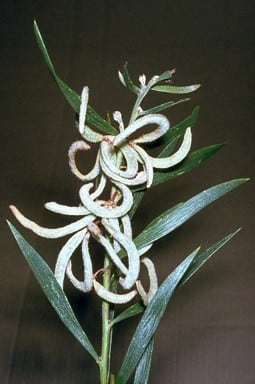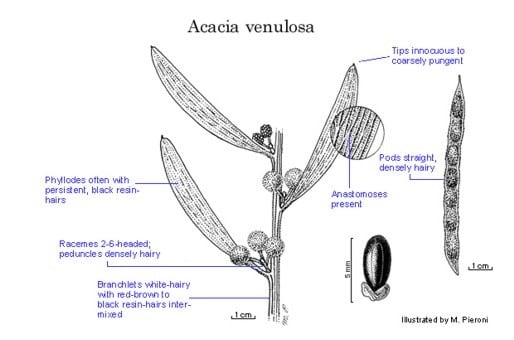Acacia venulosa Benth.
WATTLE
Acacias of Australia
Family
Fabaceae
Distribution
Most common in the Stanthorpe region of south-eastern Qld and adjacent parts of N.S.W. (on the North Coast S to c. 15 km NW of Corindi Beach, Northern Tablelands S to c. 35 km SSE of Armidale and the North Western Slopes in the Howell area); it also occurs further N on the Blackdown Tableland near Blackwater in central Qld.
Description
Shrub 0.5–3 m high. Branchlets angular-ribbed at extremities, variably white-puberulous with red-brown to black resin-hairs intermixed. Phyllodes ascending, narrowly elliptic, straight to ±incurved, (3–) 5–10 cm long, 4–15 (–22) mm wide, acute or obtuse, coarsely pungent or innocuous, coriaceous, glabrous or subglabrous except margins sometimes ±appressed-hairy, with black resin-hairs often persistent on faces, with 3 main nerves and longitudinally anastomosing minor nerves between them; gland 1–4 mm above pulvinus. Inflorescences mostly 2–6-headed racemes; raceme axes to 1 cm long; peduncles 2–10 mm long, densely puberulous; heads globular, 6–9 mm diam., 30-40-flowered, golden; bracteoles linear-spathulate, with laminae rounded or minutely apiculate. Flowers 5-merous; sepals usually ±free. Pods linear, straight, to ±7.5 cm long, 5–7 mm wide, thinly crustaceous, densely white-villous. Seeds longitudinal, 4.5 mm long, ±3 mm wide; aril terminal.
Habitat
Grows in understorey in eucalypt woodland in sandy, gravelly and loam soils on granite hills, occasionally in heathland.
Specimens
Qld: Pyramids Rd, Girraween Natl Park, R.S. & R.A.Cowan A-793 (CANB, K, PERTH). N.S.W.: 9.7 km c. S of Coaldale, 27.4 km NNW of Grafton, R.G.Coveny 3865 & K.Thurtell (NSW); New England Hwy, 70.4 km S of Tenterfield, R.Coveny 2247 (NSW, PERTH).
Notes
Closely related to A. lanigera var. lanigera (with which it has often been merged as a variety) which differs by its normally sharply pungent phyllodes, lack of black resin-hairs on the branchlets, ±sessile bracteoles, its sepals are at least two-thirds united, and curved to coiled pods; see R.S.Cowan & B.R.Maslin, Nuytsia 10: 65–66 (1995), for further details. Also similar to A. baeuerlenii.
G.Bentham, London J. Bot. 1: 367 (1842), described A. venulosa var. lanata based on Cunningham 91 and 98, but these specimens appear to represent A. ixiophylla, see R.S.Cowan & B.R.Maslin, Nuytsia 10: 72 (1995), for discussion.
On some specimens from N.S.W. the sepals are sometimes 1/2-united; elsewhere the sepals are free or shortly united at their base.
The specimen ‘12.8 km S of Wagga Wagga, 19 Dec. 1951, G.Withers (NSW)’ cited by R.S.Cowan & B.R.Maslin, Nuytsia 10: 71 (1995), as Acacia venulosa (representing its southern limit as an outlying population) has since been re-determined as A. lanigera var. lanigera, which has been commonly collected from the Wagga Wagga region. The occurrence of A. venulosa in the Warrumbungle Ra., N.S.W., has possibly been confused with A. lanigera or intermediates between A. lanigera and A. venulosa, and requires further investigation. Specimens from the Warrumbungle Ra. at Herb. NSW have mostly been placed under A. lanigera var. lanigera, fide P.G.Kodela (pers. comm.).
FOA Reference
Data derived from Flora of Australia Volumes 11A (2001), 11B (2001) and 12 (1998), products of ABRS, ©Commonwealth of Australia
Author
Minor edits by B.R.Maslin & J.Reid
R.S.Cowan, B.R.Maslin
This identification key and fact sheets are available as a mobile application:
URL: https://apps.lucidcentral.org/wattle/
© Copyright 2018. All rights reserved.











